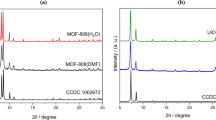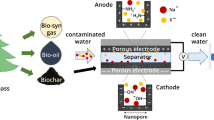Abstract
A N’-N’-di-n-hexyl-thiodiglycolamide and 2,2’-[(2-ethylhexyl)imino]bis[N,N-bis(2-ethylhexyl)acetamide] impregnated porous silica-based adsorbent was prepared for enhancing the adsorption of palladium ions from simulated high-level liquid waste. The adsorbent exhibited a relatively fast palladium response and selectivity without the use of additional modification reagents. Palladium ions were adsorbed over a wide nitric acid range of 0.6−5 M and a broad temperature range of 288−323 K. The uniform distribution of adsorbed palldium ions onto the study adsorbent was confirmed by PIXE. Successful recovery of more than 90% of the palladium ions was achieved using 0.1 M thiourea via separation by column experiments. Based on the obtained data, it is expected that the prepared adsorbent can be used for the practical separation of palladium ions from high-level liquid waste.











Similar content being viewed by others
References
Rahimpour MR, Samimi F, Babapoor A, Tohidian T, Mohebi S (2017) Palladium membranes applications in reaction systems for hydrogen separation and purification: a review. Chem Eng Process: Process Intensificat 121:24–49
Kim MS, Kim EY, Jeong J, Lee JC, Kim W (2010) Recovery of Platinum and palladium from the spent petroleum catalysts by substrate dissolution in sulfuric acid. Mater Trans 51(10):1927–1933
Ponoua J, Wang LP, Dodbiba G, Fujita T (2018) Separation of palladium and silver from semiconductor solid waste by means of liquid-liquid-powder extraction using dodecyl amine acetate as a surfactant collector. Sep Purif Technol 191:86–93
Yang XJ, Chen JF, Hu LS, Wei JY, Shuai MB, Huang DS, Yue GZ, Astruc D, Zhao PX (2019) Palladium separation by Pd-catalyzed gel formation via alkyne coupling. Chem Mater 31(18):7386–7394
Godlewskazylkiewicz B, Lesniewska B, Gasiewska U, Hulanicki A (2000) Ion-exchange preconcentration and separation of trace amounts of platinum and palladium. Anal Lett 33(13):2805–2820
Niskavaara H, Kontas E (1990) Reductive coprecipitation as a separation method for the determination of gold, palladium, platinum, rhodium, silver, selenium and tellurium in geological samples by graphite furnace atomic absorption spectrometry. Anal Chim Acta 231:273–282
Kim DI, Gwak G, Dorji P, He D, Puntsho S, Hong S, Shon H (2018) Palladium recovery through membrane capacitive deionization from metal plating wastewater. ACS Sustain Chem Eng 6(2):1692–1701
Kim S, Song MH, Wei W, Yun YS (2015) Selective biosorption behavior of escherichia coli biomass toward Pd(II) in Pt(IV)-Pd(II) binary solution. J Hazard Mater 283:657–662
Tamahkar E, Bakhshpour M, Andaç M, Denizli A (2017) Ion imprinted cryogels for selective removal of Ni(II) ions from aqueous solutions. Sep Purif Technol 179:36–44
Neyestani MR, Shemirani F, Mozaffari S, Alvand M (2017) A magnetized graphene oxide modified with 2-mercaptobenzothiazole as a selective nanosorbent for magnetic solid phase extraction of gold(III), palladium(II) and silver(I). Microchim Acta 184:2871–2879
Ito T, Kim S-Y, Nagano N, Hitomi K (2017) Effects of γ-ray irradiation on thiodiglycolamide-type extractant-impregnated adsorbents for separation of platinum group metals from high-level liquid waste. Energy Procedia 131:195–202
Cibula M, Inaba Y, Li YJ, Suzuki T, Narita H, Takeshita K (2019) Effect of HNO3 concentration on the Pd(II) extraction properties using a thiodiglycolamide compound. Solvent Extr Res Dev 26(2):43–49
Ruhela R, Singh KK, Tomar BS, Sharma JN, Kumar M, Hubli RC, Suri AK (2012) Amberlite XAD-16 functionalized with 2-acetyl pyridine group for the solid phase extraction and recovery of palladium from high level waste solution. Sep Purif Technol 99:36–43
Guo G, Xu YL, Yang XX, Wang F, Zhou F, Yu JX, Chi R (2017) Effect of HNO3 concentration on a novel silica-based adsorbent for separating Pd(II) from simulated high level liquid waste. Sci Rep 7(1):11290
Sasaki Y, Tsubata Y, Kitatsuji Y, Sugo Y, Shirasu N, Morita Y, Kimura T (2013) Extraction behavior of metal ions by TODGA, DOODA, MIDOA, and NTAamide Extractants from HNO3 to n-Dodecane. Solvent Extr Ion Exch 31(4):401–415
Moore KL, Barac M, Brajković M, Bailey MJ, Siketić Z, Radović IB (2019) Determination of deposition order of toners, inkjet inks, and blue ballpoint pen combining MeV-secondary ion mass spectrometry and particle induced x-ray emission. Anal Chem 91(20):12997–13005
Wu Y, Zhang XX, Wei YZ, Mimura H (2017) Development of adsorption and solidification process for decontamination of Cs-contaminated radio-active water in Fukushima through silica-based AMP hybrid adsorbent. Sep Purif Technol 181:76–84
Ning SY, Zhang SC, Zhang W, Zhou J, Wang SY, Wang XP, Wei YZ (2020) Separation and recovery of Rh, Ru and Pd from nitrate solution with a silica based IsoBu-BTP/SiO2-P adsorbent. Hydrometallurgy 191:105207
Yu Q, Ning SY, Zhang W, Wang XP, Wei YZ (2018) Recovery of scandium from sulfuric acid solution with a macro porous TRPO/SiO2-P adsorbent. Hydrometallurgy 181:74–81
Matsuyama S, Ishii K, Yamazaki H, Sakamoto R, Fujisawa M, Amartaivan Ts, Ohishi Y, Rodriguez M, Suzuki A, Kamiya T, Oikawa M, Arakawa K, Matsumoto N (2003) Preliminary results of microbeam at Tohoku University. Nucl Instrum Methods Phys Res B 210:59–64
Awual MdR, Khraisheh M, Alharthi NH, Luqman M, Islam A, Karim MR, Rahman MM, Khaleque MdA (2018) Efficient detection and adsorption of cadmium(II) ions using innovative nano-composite materials. Chem Eng J 343:118–127
Wu Y, Kim SY, Tozawa D, Ito T, Tada T, Hitomi K, Kuraoka E, Yamazaki H, Ishii K (2012) Equilibrium and kinetic studies of selective adsorption and separation for strontium using DtBuCH18C6 loaded resin. J Nucl Sci Technol 49(3):320–327
Wu H, Kim SY, Miwa M, Matsuyama S (2021) Synergistic adsorption behavior of a silica-based adsorbent toward palladium, molybdenum, and zirconium from simulated high-level liquid waste. J Hazard Mater 411:125136
Xiao J, Hu R, Chen GC (2020) Micro-nano-engineered nitrogenous bone biochar developed with a ball-milling technique for high-efficiency removal of aquatic Cd(II), Cu(II) and Pb(II). J Hazard Mater 387:121980
Arai Y, Watanabe S, Ohno S, Nomura K, Nakamura F, Arai T, Seko N, Hoshina H, Hagura N, Kubota T (2020) Microscopic analyses on Zr adsorbed IDA chelating resin by PIXE and EXAFS. Nucl Instrum Methods Phys Res B 477:54–59
Petalaa E, Dimos K, Douvalis A, Bakas T, Tucek J, Zboril R, Karakassides MA (2013) Nanoscale zero-valent iron supported on mesoporous silica: characterization and reactivity for Cr(VI) removal from aqueous solution. J Hazard Mater 261:295–306
Anpilogova GR, Khisamutdinov RA, Golubyatnikova LG, Murinov YuI (2017) Extraction of palladium(II) with (RS)-1-[2-(2,4-dichlorophenyl)pentyl]-1H-1,2,4-triazole from nitric acid solutions. Russ J Gen Chem 87(1):132–138
Mu WJ, Du SZ, Li XL, Yu QH, Wei HY, Yang YC, Peng SM (2019) Removal of radioactive palladium based on novel 2D titanium carbides. Chem Eng J 358:283–290
Ngah WSW, Fatinathan S (2010) Adsorption characterization of Pb(II) and Cu(II) ions onto chitosan-tripolyphosphate beads: kinetic, equilibrium and thermodynamic studies. J Environ Manage 91(4):958–969
Syafiuddin A, Salmiati S, Jonbi J, Fulazzaky MA (2018) Application of the kinetic and isotherm models for better understanding of the behaviors of silver nanoparticles adsorption onto different adsorbents. J Environ Manage 218:59–70
Hu QL, Wang Q, Feng CP, Zhang ZY, Lei ZF, Shimizu K (2018) Insights into mathematical characteristics of adsorption models and physical meaning of corresponding parameters. J Mol Liq 254:20–25
Zou Q, Wu Y, Shu QD, Ning SY, Wang XP, Wei YZ, Tang FD (2018) Separation of palladium along with minor actinides by isoBu-BTP/SiO2-P Adsorbent from high-level liquid waste. J Chem Eng Data 63(8):2931–2939
Author information
Authors and Affiliations
Corresponding author
Additional information
Publisher's Note
Springer Nature remains neutral with regard to jurisdictional claims in published maps and institutional affiliations.
Rights and permissions
About this article
Cite this article
Kubota, M., Wu, H. & Kim, SY. Combination of N’-N’-di-n-hexyl-thiodiglycolamide and 2,2’-[(2-ethylhexyl)imino]bis[N,N-bis(2-ethylhexyl) acetamide] for the enhanced adsorption of palladium ions from simulated high-level liquid waste. J Radioanal Nucl Chem 331, 1731–1740 (2022). https://doi.org/10.1007/s10967-022-08230-3
Received:
Accepted:
Published:
Issue Date:
DOI: https://doi.org/10.1007/s10967-022-08230-3




